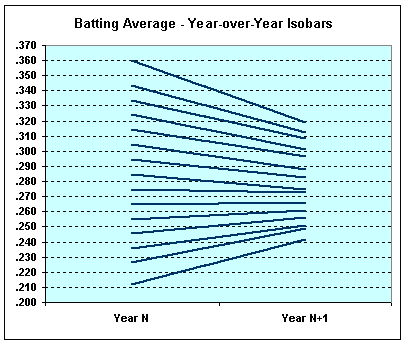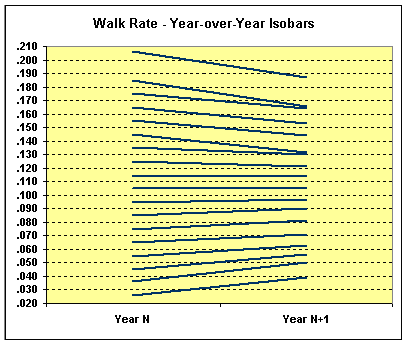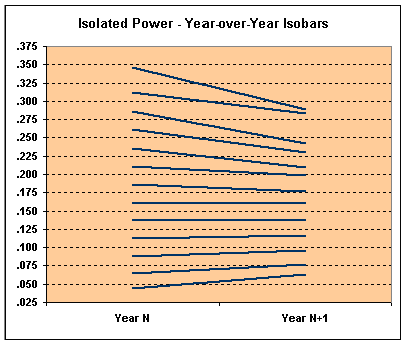Your favorite player hit .360 last season. If you know nothing else, what can you expect him to hit this season?
This isn’t meant to be a trick question; let’s assume the guy had at least 500 at bats in the previous season. Gates Brown and Shane Spencer need not apply. What’s your best guess? .350? .340? Not likely.
The evidence is overwhelming. Let’s look at all hitters since WWII who hit .350 or better in at least 500 at bats; the only other requirement is that they had at least 250 at bats in the year following.
Name Year BA (n) BA (n+1) Delta ----------------------------------------------------- Aaron, Hank 1959 .355 .292 -.063 Boggs, Wade 1983 .361 .325 -.036 Boggs, Wade 1985 .368 .357 -.011 Boggs, Wade 1986 .357 .363 +.006 Boggs, Wade 1987 .363 .366 +.003 Boggs, Wade 1988 .366 .330 -.036 Boudreau, Lou 1948 .355 .284 -.071 Carew, Rod 1974 .364 .359 -.005 Carew, Rod 1975 .359 .331 -.028 Carew, Rod 1977 .388 .333 -.055 Cash, Norm 1961 .361 .243 -.118 Clemente, Roberto 1961 .351 .312 -.039 Clemente, Roberto 1967 .357 .291 -.066 Cooper, Cecil 1980 .352 .320 -.032 Erstad, Darin 2000 .355 .258 -.097 Garciaparra, Nomar 1999 .357 .372 +.015 Garr, Ralph 1974 .353 .278 -.075 Gwynn, Tony 1984 .351 .317 -.035 Gwynn, Tony 1987 .370 .313 -.057 Gwynn, Tony 1995 .368 .353 -.016 Gwynn, Tony 1997 .372 .321 -.051 Helton, Todd 2000 .372 .336 -.037 Kuenn, Harvey 1959 .353 .308 -.045 Madlock, Bill 1975 .354 .339 -.016 Mantle, Mickey 1956 .353 .365 +.012 Martinez, Edgar 1995 .356 .327 -.030 Mattingly, Don 1986 .352 .327 -.025 McGee, Willie 1985 .353 .256 -.097 Musial, Stan 1946 .365 .312 -.054 Musial, Stan 1948 .376 .338 -.038 Musial, Stan 1951 .355 .336 -.019 Musial, Stan 1957 .351 .337 -.014 Olerud, John 1993 .363 .297 -.066 Olerud, John 1998 .354 .298 -.056 Piazza, Mike 1997 .362 .328 -.034 Puckett, Kirby 1988 .356 .339 -.018 Rodriguez, Alex 1996 .358 .300 -.058 Torre, Joe 1971 .363 .289 -.074 Vernon, Mickey 1946 .353 .265 -.088 Walker, Harry 1947 .363 .292 -.070 Walker, Larry 1997 .366 .363 -.003 Williams, Ted 1948 .369 .343 -.027 ----------------------------------------------------- AVERAGE .360 .319 -.041 MEDIAN .358 .326 -.040
There were 42 hitters that met the criteria; on the average, they hit about .360 in the year in question. The next year?
- 38 of the 42 hitters (90%) saw a decline in their batting average;
- 13 of 42 (31%) failed to hit .300;
- The average drop-off in batting average was 41 points; the median drop-off in batting average was 40 points.
We don’t need to whip this horse too much, since the data pretty much speaks for itself. It’s a commonly stated stathead credo that batting average is subject to a higher degree of random fluctuation than most other components of offensive performance, and numbers like this are the reason why.
The .350+ hitters are certainly an exceptional group, with a few absurdities like Ralph Garr and Darin Erstad (ducking flying halos) tossed in, but they’re hardly alone in exhibiting a very profound tendency to regress to the mean.
Using the same criteria as described above, there were 44 hitters who hit between .340 and .350 in a single season. Of those hitters, 39 (89%) saw their batting average decline in the next year; as a group, they hit just over .312.
There were 85 hitters who hit between .330 and .340. Of those, 72 (85%) saw their batting average decline; as a group, they hit .308 the next time around.
There were 144 hitters who hit between .320 and .330. Of those, 118 (82%) saw their batting average decline. They hit, on the average, .301 the next season. And so on.
Here, let’s try one of those visualization exercises.

The chart was derived by splitting all hitters into groups of 10 points of batting average apiece, as we were doing above, and comparing the group’s average BA from one year to the next. We know about the tendency for very high batting averages to decline, but it’s not until a hitter is down to .275 or so that we don’t need to worry much about regression. Conversely, if a hitter is much below .260, he’s a good bet to improve. While there are some selection bias problems in play here–not every .220 hitter is going to be invited back for another go–the phenomenon certainly cuts both ways.
The next question–and you can probably guess the answer–is whether other offensive statistics exhibit the same pattern. Using the same grouping approach, here’s the isobar chart for walk rate.

Walk rate is more stable from year-to-year than batting average. It regresses to the mean, but not as much, which is evident from the flatter bars.
Here’s isolated power, which is somewhere in between.

The chart is actually somewhat asymmetrical–a hitter coming off an extremely good power season can expect to drop-off more profoundly than a hitter coming off an extremely poor power can expect to rebound. Still, isolated power is substantially more stable than batting average; for our group of hitters, the year-to-year correlations were .78 and .49, respectively.
I suspect that, in a refreshing turn of events, a lot of the good BP readers out there are going to think this is a rather superficial analysis, but really that’s the point. Regression to the mean isn’t some lofty concept or novel idea–it’s the cold hard fact. If a hitter hit .340 or better last year, odds are more than 90% that he’ll experience a drop-off in the following season. That’s somewhere alongside a Color Me Badd video on the opposite side of subtle, and it needs to be accounted for when evaluating players.
Randomness–catch the fever! God may not roll dice, but I’m pretty sure he’s in one of Joe Sheehan’s Strat leagues (he’s the one who took a flier on Runelvys Hernandez).
I’m not on a word count, but…
- I was going to write some clever, PECOTA-friendly article about Mike Piazza‘s potential position shift this week, but there just isn’t the data to work with. There are a few famous catchers who switched positions late in their careers–Johnny Bench‘s name is always mentioned, and you’ve also got Yogi Berra and Ted Simmons (only Berra experienced much sustained success after his shift). But there aren’t very many, and the reason is really very simple–in most cases, it just ain’t worth it. Mike Piazza will be the best hitter on the Mets no matter what position he plays. That almost never happens; nobody was yearning to extend Andy Allanson‘s career.
I’m not saying there isn’t a defensible, quantitative way to answer the question, the chewy part of which isn’t what effect the move would have on the Mets (Vance Wilson < Tony Clark) but what effect it would have on Piazza. I am saying that I haven’t been able to come up with one.
But really, it’s more of a medical question. Catching is hazardous to a player’s health. If you quit smoking at age 34, how much of the damage is reversible?
Thank you for reading
This is a free article. If you enjoyed it, consider subscribing to Baseball Prospectus. Subscriptions support ongoing public baseball research and analysis in an increasingly proprietary environment.
Subscribe now